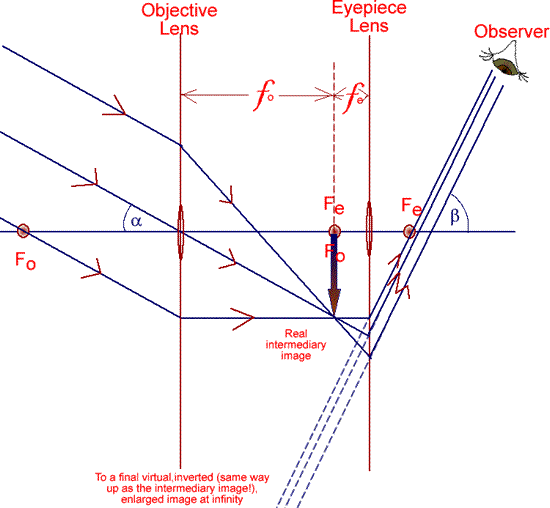|
 The refracting telescope works by bending
light with lenses. The objective lens makes a small real image of
the object so that the eyepiece lens can act as a magnifying glass and produce an enlarged image of the objective lens's image! The refracting telescope works by bending
light with lenses. The objective lens makes a small real image of
the object so that the eyepiece lens can act as a magnifying glass and produce an enlarged image of the objective lens's image!
The
following factors are important in making a good quality instrument:
 Lens
quality - poor quality lenses produce a poor image
- the curvature of the lens must be perfectly part of a sphere and the density of the glass uniform Lens
quality - poor quality lenses produce a poor image
- the curvature of the lens must be perfectly part of a sphere and the density of the glass uniform
 Lens
diameter - brightness and detail observed depends on the surface area of the lens. A 12 cm
lens can resolve detail nine times better than a 4 cm lens - area depends on the square of the diameter. Lens
diameter - brightness and detail observed depends on the surface area of the lens. A 12 cm
lens can resolve detail nine times better than a 4 cm lens - area depends on the square of the diameter.
 Angular
magnification - the ratio of the angle subtended by the image of the object when using the instrument to view it, to the angle subtended at the eye of the observer when viewing the object without that instrument Angular
magnification - the ratio of the angle subtended by the image of the object when using the instrument to view it, to the angle subtended at the eye of the observer when viewing the object without that instrument
The
diagram shows the telescope when it is set up in normal adjustment - that means to view an object at infinity, therefore the focal point of both the eyepiece lens and the objective lens are set to coincide (see diagram below). Note that the length of the telescope is then set at the sum of the focal lengths of the two lenses. A very powerful telescope will have a big objective lens focal length. It will therefore be longer than a less powerful one.

Parallel rays of light
from a distant object meet at the principal focus Fo of the objective
lens.There it forms an intermediary real inverted image. The eyepiece
is set so that the intermediary image is the focal length away from its principal focus Fe. Light from the intermediary image spreads out until it meets the eyepiece and forms an image at infinity - parallel
rays emerge from the eyepiece and enter the eye of the observer. The observer traces the rays entering his/her eye back to infinity to form an inverted, virtual image of the original object.
 A ray arrives at the objective at a small
angle α to the axis. A ray arrives at the objective at a small
angle α to the axis.
 The angle to the axis of the ray leaving the telescope is β. The angle to the axis of the ray leaving the telescope is β.
The
angular magnification can be worked out by the simple formula:

where α
and β are small angles in radians.
 The
angle α is the angle subtended by the object to the unaided eye. The
angle α is the angle subtended by the object to the unaided eye.
 The
angle β is the angle subtended by the image to the eye. The
angle β is the angle subtended by the image to the eye.
The
magnification can also be shown to be related to the focal lengths of the
lenses by:

Where:
 fo is the focal length of the objective lens and fo is the focal length of the objective lens and
 fe is the focal length of the eyepiece lens fe is the focal length of the eyepiece lens
Disadvantages of using lenses in a telescope:
 They refract light of different colours by different amounts. See dispersion. This leads to chromatic aberration. The image is therefore colour-distorted. They refract light of different colours by different amounts. See dispersion. This leads to chromatic aberration. The image is therefore colour-distorted.
 They do not transmit 100 % of the light; some is lost (absorbed/reflected). They do not transmit 100 % of the light; some is lost (absorbed/reflected).
 Large lenses are very difficult to make. Large lenses are very difficult to make.
 To get a good magnification you need an objective lens with a very long focal length. This can make the telescope very long. The largest known is 20 m, with a 1 m wide objective lens. To get a good magnification you need an objective lens with a very long focal length. This can make the telescope very long. The largest known is 20 m, with a 1 m wide objective lens.
----------------------------------------------------------------------------
See reflecting telescpes
|







 The refracting telescope works by bending
light with lenses. The objective lens makes a small real image of
the object so that the eyepiece lens can act as a magnifying glass and produce an enlarged image of the objective lens's image!
The refracting telescope works by bending
light with lenses. The objective lens makes a small real image of
the object so that the eyepiece lens can act as a magnifying glass and produce an enlarged image of the objective lens's image! 



